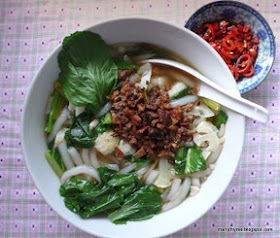 |
| Minced beef with loh shi fun |
Oh no no, don't misread the title of this post. That's mince AND rat's tails noodles. The noodles are called that in Chinese –
loh shi fun – because of their shape: short and fat and resembling a rodent's end zone.
This is the first time I am cooking with the rice noodle,
and it also happens to be the first time I am eating it!
I've seen it prepared by hawkers, but have never been persuaded to eat it, preferring instead to have the more conventional kueh teow or yellow mee. It isn't a prejudice; I just never thought about it.
At my neighbourhood grocers the other day, it was there along with the other noodles and I thought, why not? I was in the mood for a soup and I could use it and see what happens.
And now, I think I'm in love with this noodle.
It's so easy to eat! I have no problem using chopsticks but because these noodles are short, I can just use a Chinese soup spoon while I sit in front of the TV – no spillover, splashes or mess, and I get a few noodles, the condiments
and the all-important broth all in one scoop.
The broth I made for the following recipe was nothing out of the ordinary – a spoonful of stock concentrate added to water to get chicken-flavoured soup. I made it special for myself with hot minced beef.
Because I used only a small amount of meat, and it was left over from a dish I had to prepare for a cookbook review, I minced it up myself by hand. When I was little, I remember how my maternal great uncle used to mince great hunks of meat on special days when he fed a large crowd. He was a headmaster but was the most fantastic cook. He lived next door to us, in one compound, so when we knew he was cooking his amazing curry mee or braised pork slices with yam, we would eagerly wait for him to holler from across the hedge, "
Makan!" and we would all scoot over.
It was fascinating to watch Great Uncle Ben mince meat. He would put a slab of pork or beef on one of those thick wooden chopping blocks cut from a tree trunk, slice them using a cleaver, and tenderise them first using the dull edge of the knife. Next, he would pound away as he flattened the meat into one lean layer. Then he would fold one side of the meat layer onto itself, slide the knife blade beneath it, deftly give it a quarter turn and then on with more chopping, repeating the process until he got the mince as fine as he needed.
LOH SHI FUN SOUP WITH SPICY MINCED MEAT Serves 2
100g loh shi fun
2 teaspoon sesame oil
600ml water
1 tablespoon chicken stock concentrate
1 large clove garlic, thinly sliced
100g vegetables (mustard green, cauliflower, beans etc), cut into small pieces
Cooking oil
Sliced red chillies and soy sauce
Minced meat
100g meat (beef, pork or chicken), cubed
1 small shallot, chopped
1 tablespoon thick soy sauce
Large pinch of chilli flakes
Freshly ground black pepper
1 teaspoon sesame oil
Soy sauce to taste
- Mix loh shi fun noodles with thick soy sauce and sesame oil; set aside.
- Prepare the mince. Place the cubes of meat on a cutting board; using a cleaver or heavy chef's knife, mince the meat coarsely (do this manually so you don't get finely ground meat). Spread the mince out on the board and sprinkle with the chopped shallot, thick soy sauce, chilli flakes and black pepper to taste. Drizzle with sesame oil and soy sauce. Fold the meat onto itself and continue chopping, incorporating the seasonings. Place meat in a bowl and set aside for 10 minutes.
- In a saucepan, heat 2 tablespoons cooking oil over medium high heat and then add meat. Cook until the meat is brown and crisp, 3-5 minutes. Remove meat and set aside.
- Add more oil to the pan if necessary and fry the garlic until lightly browned. Add water and stock concentrate (or use real stock if desired) and bring to the boil. Add vegetables and cook until softened, then add noodles. Season to taste. Pour into bowls; garnish with the minced meat and serve immediately with sliced red chillies and soy sauce.
PRINTABLE RECIPE

